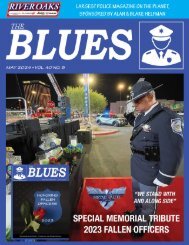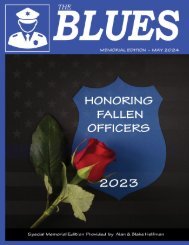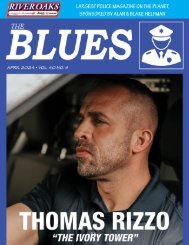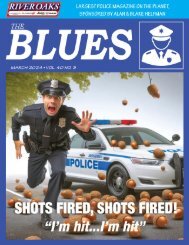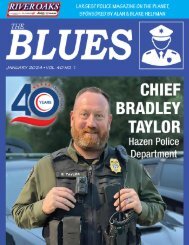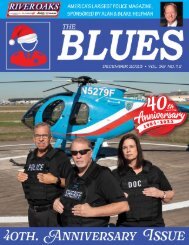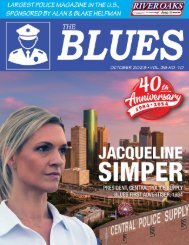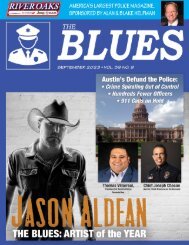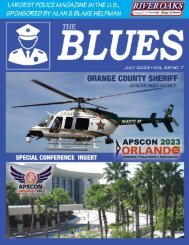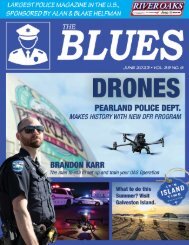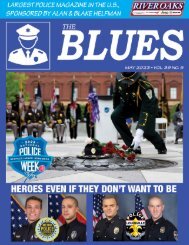MARCH 2022. Blues Vol 38 No. 3
FEATURES 42 Vote Their Ass Out 46 Remembering Those We’ve Lost to COVID 50 Remembering Those We’ve Lost to LOD Deaths 56 10-Year Olds Dream Becomes a Reality DEPARTMENTS 8 Publisher’s Thoughts 12 Editor’s Thoughts 14 Your Thoughts 16 News Around the US 32 Where to Eat - El Mercadito 34 Where to Shop - Central Police Supply 38 Defending Your Rights - James Wood 75 War Stories 84 Aftermath 88 Open Road 92 Healing Our Heroes 94 Daryl’s Deliberations 98 HPOU - From the President, Douglas Griffith 100 Light Bulb Award - Judge Dora & Her Posse 102 Running 4 Heroes 104 Blue Mental Health with Tina Jaeckle 106 Off Duty with Rusty Barron 108 Ads Back in the Day 112 Parting Shots 114 Now Hiring - L.E.O. Positions Open in Texas 138 Back Page
FEATURES
42 Vote Their Ass Out
46 Remembering Those We’ve Lost to COVID
50 Remembering Those We’ve Lost to LOD Deaths
56 10-Year Olds Dream Becomes a Reality
DEPARTMENTS
8 Publisher’s Thoughts
12 Editor’s Thoughts
14 Your Thoughts
16 News Around the US
32 Where to Eat - El Mercadito
34 Where to Shop - Central Police Supply
38 Defending Your Rights - James Wood
75 War Stories
84 Aftermath
88 Open Road
92 Healing Our Heroes
94 Daryl’s Deliberations
98 HPOU - From the President, Douglas Griffith
100 Light Bulb Award - Judge Dora & Her Posse
102 Running 4 Heroes
104 Blue Mental Health with Tina Jaeckle
106 Off Duty with Rusty Barron
108 Ads Back in the Day
112 Parting Shots
114 Now Hiring - L.E.O. Positions Open in Texas
138 Back Page
Create successful ePaper yourself
Turn your PDF publications into a flip-book with our unique Google optimized e-Paper software.
BY TOM KENNEDY, B&G EDITOR<br />
War story about violent 1970s HPD drug wars<br />
set the stage for events leading to creation of<br />
Houston Police Officers Union<br />
his poison. Choosing nights in Central<br />
Patrol, he quickly became intimate with<br />
the Third Ward culture despite the fact<br />
he had never been able to vote or buy<br />
weapons or ammunition, had never<br />
gotten drunk and always locked his<br />
patrol car doors.<br />
Many officers learned before decade’s<br />
end that Thomas knew the meaning of<br />
perseverance. He persevered through<br />
the bloodshed and the tough initiation<br />
dished out by the department. He even<br />
was recruited by the Park Place Rangers,<br />
the only way a young officer could<br />
join the rugged, no-nonsense patrol<br />
known for taking no prisoners. Instead<br />
of worrying about the lack of legal<br />
representation for officers involved in<br />
shootings or fretting over insurance<br />
co-pays that added up too quickly on<br />
pay day, Thomas built a solid reputation<br />
for the savvy needed to make cases<br />
that stood<br />
own way of doing things.<br />
AGGRESSIVE WAR ON DRUGS<br />
The narcs set records for blowing<br />
the division’s monthly drug budget the<br />
first three days of a new month because<br />
they were making bigger busts, requiring<br />
much larger sums. On the night<br />
shift, Lieutenant Billy Ripley, Jim Kilty<br />
and his aggressors in the war on drugs<br />
were doing the same thing. Each of the<br />
narcs learned to always be part of a<br />
task force that involved Harris County<br />
officers, the U. S. Drug Enforcement<br />
Agency and the Texas Department of<br />
Public Safety. One task force member<br />
or another always had the money the<br />
underfunded HPD officers needed for<br />
their next bust.<br />
The workload added up, especially<br />
the time in court. The narcs worked sixteen-hour<br />
days and sometimes on their<br />
Recruiting because she was one of only<br />
a few females who could pass HPD’s<br />
tricky agility test. She became HPD’s<br />
second female narc, with braces on her<br />
teeth and a Sunday school image.<br />
She had been a narc for only three<br />
months when the Golfcrest warrant<br />
situation arose. Woods needed help to<br />
gain entry to the apartment and secure<br />
the occupants inside. He radioed Thomas<br />
as he worked late from the day shift.<br />
Doyle Green bumped him and they also<br />
got Nathan Brumley to volunteer to<br />
participate. The sergeant going to the<br />
scene was Gene Cox.<br />
The sergeant and three other officers<br />
arrived and shared information about<br />
the case. The guy in the apartment was<br />
sixty-year-old Thomas Garza Malone,<br />
the poster boy for the early release<br />
Author’s <strong>No</strong>te: The history of the Houston<br />
Police Officers Union came in three<br />
phases: 1) the formation of the Houston<br />
Police Officers Association in the 1940s;<br />
2) the creation of the Houston Police Patrolman’s<br />
Union in the late 1970s; and 3)<br />
the merging of HPOA and HPPU to form<br />
HPOU in the 1990s. The following story,<br />
based on a chapter in Houston Blue, the<br />
Story of HPD, details the formation of<br />
HPPU, whose history begins with a “war<br />
story” from the violent drug wars in<br />
Houston in the 1970s.<br />
Pappy Bond had a plan in late 1974.<br />
The new captain in Narcotics had taken<br />
over a division troubled by unsafe<br />
arrest practices and accusations of brutality,<br />
wiretapping and other questionable<br />
activities that often turned the tide<br />
in the criminals’ favor. Bond attacked<br />
the growing drug problem in the Bayou<br />
City through a special inter-departmental<br />
recruitment technique. He<br />
perused the lists of arrests from Patrol<br />
and wrote down the names of the arresting<br />
officers most often appearing.<br />
On his yellow notepad he scribbled<br />
the names of the top three from<br />
Central Patrol, <strong>No</strong>rtheast, Shepherd<br />
and Park Place. He interviewed each<br />
of them, flattered their egos by citing<br />
their aggressiveness, and appealed to<br />
their purposeful demeaner as being<br />
just what HPD needed to take on drug<br />
dealers.<br />
He sought and signed up the people<br />
who later nicknamed themselves the<br />
“buffalo hunters” on the day shift. The<br />
night shift became known as “Ripley’s<br />
Raiders” after Narcotics Lieutenant Billy<br />
Ripley. These hunters and raiders were<br />
younger officers unafraid to plunge<br />
head-on into the more challenging and<br />
dangerous police situations and live to<br />
write detailed reports.<br />
BUFFALO HUNTERS FORM<br />
One of them was Bob Thomas,<br />
who endured his share of meanness<br />
and violence as a patrolman in Third<br />
Ward and with the Park Place Rangers,<br />
known in the 1970s as HPD’s toughest<br />
patrol division. In his three years on the<br />
force, Thomas had heard more shots<br />
fired and saw more blood than hundreds<br />
of officers with far more years on<br />
any beat.<br />
The “buffalo hunters” met for the first<br />
time in early 1975, each finding himself<br />
in a roomful of strangers, a condition<br />
that quickly changed. Thomas threw<br />
in with Officer Doyle Green of Central<br />
Patrol. The modus operandi meant<br />
working in groups on shifts. Thomas’<br />
group worked days and also included<br />
Rick Ashwood, Kenny Williamson and<br />
Joe Otis. The narcs worked undercover,<br />
using tips from street people and informants<br />
to make buys of heroin and large<br />
amounts of marijuana. They grew long<br />
hair and beards and dressed the part.<br />
They put in long hours together and<br />
frequently socialized off-duty.<br />
Thomas grew up in Oak Forest on<br />
Houston’s <strong>No</strong>rthside, an ideal backdrop<br />
for conscientious young men and women<br />
of the early sixties. Many graduates<br />
of Waltrip High School, Thomas’ alma<br />
mater, became Houston police officers.<br />
An especially poignant fact in history<br />
is that three Waltrip graduates were<br />
police officers killed in the line of duty:<br />
John Bamsch, shot to death by a robbery<br />
suspect in 1975; Timothy L. Hearn,<br />
killed by a pistol-wielding drug suspect<br />
in 1978; and John Anthony Salvaggio,<br />
killed by a hit-and-run driver in 1990.<br />
The twenty-one-year-old Thomas<br />
realized that Waltrip’s HPD tradition, his<br />
three years as a UH business major and<br />
sixteen weeks in the police academy<br />
prepared him for the Houston streets –<br />
but only to a degree. He got the same<br />
on-the-job experience as thousands<br />
of his predecessors. He graduated high<br />
enough in his academy class to pick<br />
up with supervisors and later in<br />
courts.<br />
Thomas was a quick study in drug<br />
culture. He dressed the part, talked the<br />
part and became an integral part of it<br />
just like colleagues Doyle Green, Rick<br />
Ashwood, Kenny Williamson, Jim Kilty,<br />
Tim Hearn and others. He learned the<br />
dangerous trade from more seasoned<br />
narcs such as Frank Miller, Mike Woods<br />
and Joe T. Dugger.<br />
Narcs cultivated their snitches,<br />
discreetly dropping charges against<br />
suspects in return for certain introductions.<br />
Bartering for a dismissal, the defendant<br />
was required to introduce the<br />
narcs to three people who sold drugs.<br />
The informant might participate in the<br />
first dirty buy. Then the narcs would<br />
make two more on their own, building<br />
up trust and carefully working their<br />
way through the drug-dealing chain.<br />
Captain Bond was looking good, too.<br />
By the middle of 1975, the Buffalo Hunters<br />
and Ripley’s Raiders developed and<br />
cultivated a vast network of drug dealers.<br />
In their first year, the Narcotics Division<br />
saw a 300 percent increase in drug<br />
arrests, a stark contrast to the squad of<br />
predecessors disbanded because of its<br />
days off. Thomas kept his marriage to<br />
his high school sweetheart together by<br />
spending every day off with her and his<br />
daughters. Others weren’t so lucky. The<br />
HPD divorce rate grew higher, particularly<br />
among narcs. The narcs’ workload<br />
grew heavier and, as they learned on<br />
a December night in 1975 night, it also<br />
became more dangerous.<br />
Critics of the Narcotics Division of<br />
the late seventies believed narcs were<br />
overly aggressive and careless. Too<br />
often they initiated arrest operations<br />
without fully assessing the dangers.<br />
Justices of the peace, particularly<br />
Judge Lawrence H. Wayne, eagerly<br />
demonstrated their anti-drug stance by<br />
signing search warrants without posing<br />
the detailed questions about the perilous<br />
predicament in which arresting officers<br />
would soon immerse themselves.<br />
Early the evening of December 8,<br />
1975, Officers Mike Woods and June<br />
Cain were en route to a darkened and<br />
rundown multiple-unit dwelling on<br />
Golfcrest on the southeast side. The<br />
twenty-year-old Cain was still wet<br />
behind the ears. She grew up in Pasadena<br />
and always wanted to be a cop.<br />
Cain graduated from the academy at<br />
age nineteen and spent a half year in<br />
program in the Texas prisons of the seventies.<br />
He served ten years of a ninetynine-year<br />
sentence for murder. Once<br />
paroled, he killed another man in a bar<br />
fight and did another twelve years of<br />
hard time on a life sentence for murder.<br />
Malone had nineteen-year-old stripper<br />
Bonnie Sue Hollis with him. Hollis<br />
had recently sold heroin to a narc. The<br />
buffalo hunters would have sweet,<br />
innocent-sounding Cain knock on the<br />
door and say, “It’s me,” which usually<br />
prompted the drug to open up, triggering<br />
officers to hit the door with their<br />
shoulders and order the occupants up<br />
against the wall. The ruse worked –<br />
until this night.<br />
Hollis didn’t open up. Malone jammed<br />
a two-by-four against the doorknob,<br />
burying the other end into the carpet.<br />
The officers heard the toilet flush down<br />
evidence as they kicked down the door.<br />
Flushing continued steadily as several<br />
minutes passed before the narcs gained<br />
entry to the darkened one-bedroom<br />
apartment.<br />
FIVE SHOTS HIT FOUR OFFICERS<br />
Green took the lead with his shotgun.<br />
He grabbed Hollis by the arm,<br />
eased past a small Christmas tree and<br />
stepped down a hallway. Green aimed<br />
his shotgun as he rounded the corner<br />
76 The BLUES POLICE MAGAZINE The BLUES POLICE MAGAZINE 77<br />
76 The BLUES POLICE MAGAZINE The BLUES POLICE MAGAZINE 77





